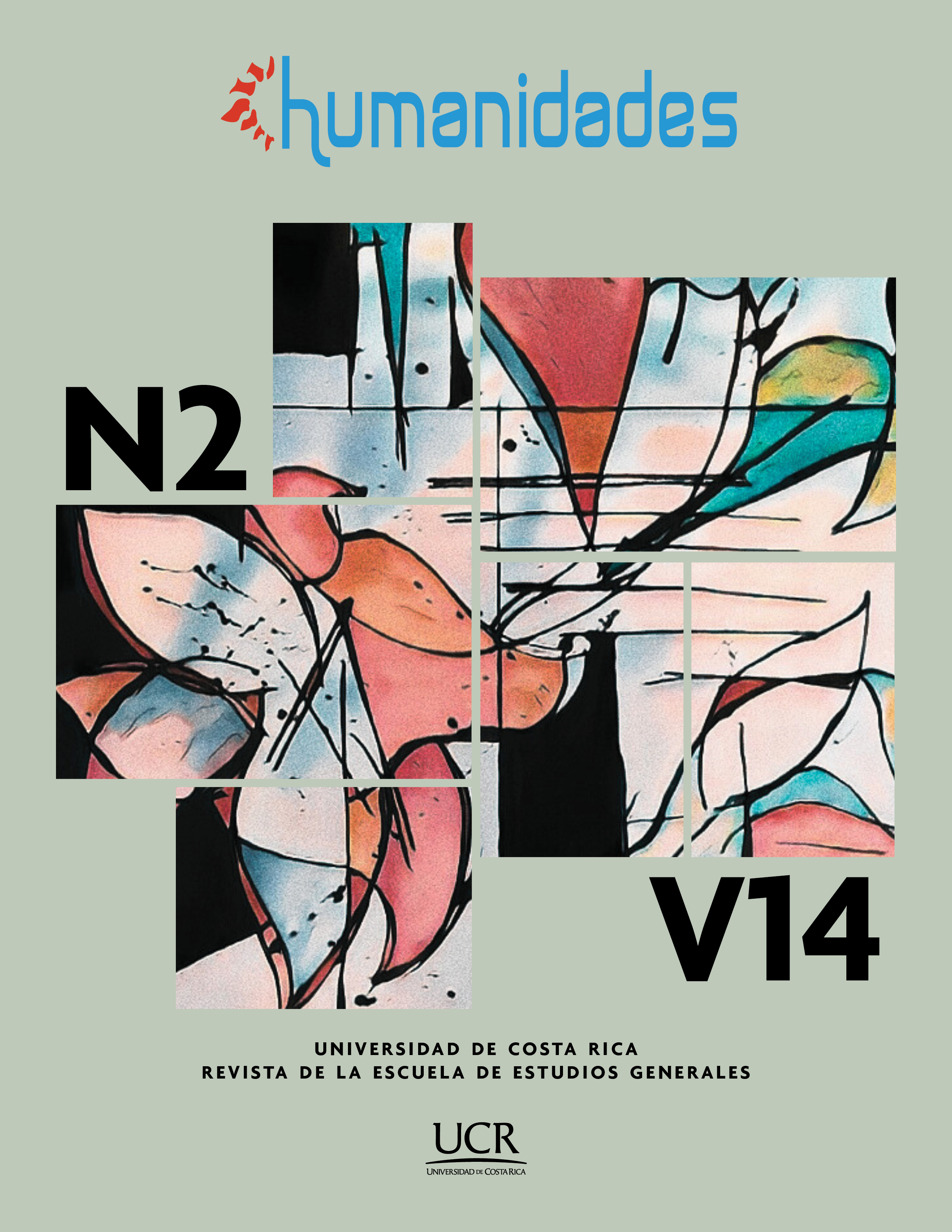Abstract
Vampires are monsters that wander between life and death, they inhabit the night, they are mysterious, dangerous and seductive; a combination that terrifies and fascinates, converted into figures that can be coupled to various socio-historical contexts such as the decline of the British Empire, the rise of capitalist modernity, among others. This work as a central axis for the debate intends to assume Dracula from its historical, political and symbolic dimension that brings him closer to ethnophagic capitalism that, through seduction and deception, traps its victims. For that purpose, this essay starts from the historical analysis of Dracula as a metaphor of capitalism and explores its various social dimensions, which has traced the evolution of Western societies. Methodologically, the choice of the theoretical literature was based on different perspectives that combine literature, history, economics, politics and fantasy, which provide a broad, complex and stressful view of Dracula.
References
Bartra, R. (1996). El salvaje en el espejo. Destino.
Bentley, C. (1972). The Monster in the Bedroom: Sexual Symbolism in Bram Stoker’s Dracula. En M. L. Carter (Ed.), The Vampire and the Critics (pp. 25-34). UMIResearch Press.
Brasil, V. (2013). La inmortalidad al alcance de la mirada. El mito del vampiro en las imágenes del cine. Revista Trama y Fondo, (35), pp. 83-102. https://dialnet.unirioja.es/servlet/articulo?codigo=4574781
Canguilhem, G. (1971). Lo normal y lo patológico. Siglo XXI Editores.
Carnero, S. (2003). Marx, El Capital y el mito vampírico. A Parte Rei: Revista de Filosofía, (29), 1-5.
Carver, T. (1984). Making Capital out of Vampires. Times Higher Educational, Supplement 15, 9-33.
Conte, D. (2008). Un bestiario futuro: exorcismos proyectivos en la ciencia ficción. En T. López Pellisa y F. Á. Moreno Serrano (Eds.), Ensayos sobre ciencia ficción y literatura fantástica (pp. 178-208). Asociación Cultural Xatafi y Universidad Carlos III de Madrid.
Cueto, R. y Díaz, C. (1997). Drácula de Transilvania a Hollywood. Nuer Ediciones.
Del Olmo, A. (2012). El eterno retorno del no-muerto como arquetipo fílmico: Una aproximación a la figura del zombi en la cultura popular contemporánea. Universitat Ramon Llull.
Díaz-Polanco, H. (2007). Identidad, globalización y etnofagia. Siglo XXI.
Douglas, M. (1996). Purity and Danger: an Analysis of Concepts of Pollution and Taboo. Routledge.
Eudave, C. (2018). Bestiaria vida. Eolas Ediciones.
Federici, S. (2016). Calibán y la bruja: mujeres, cuerpo y acumulación originaria. Editorial Abya-Yala.
Fernández, F. (2018). El origen de los seres míticos y su impacto sobre la mente humana. Argutorio: Revista de la Asociación Cultural "Monte Irago", 20(39), 82-93.
Foucault, M. (2007). Los anormales. Fondo de Cultura Económica.
Graham, E. (2002). Representations of the Post/Human: Monsters, Alien and Others in Popular Culture. Rutgers University Press.
Gregori, A. (2015). La dimensión política de lo irreal: el componente ideológico en la narrativa fantástica española y catalana. Wydawnictwo Naukowe UAM.
Gubern, R. y Prat, J. (1979). Las raíces del miedo: Antropología del cine de terror. Tusquets.
Haraway, D. (2008). When Species Meet. University of Minnesota Press.
Haro-Ibars, E. (1979). Persistencia de un mito: Drácula, príncipe de las tinieblas. Tiempo de historia,
(50), 114-121. https://gredos.usal.es/handle/10366/23881
Hyman, S. (1962). The Tangled Bank: Darwin, Marx, Freud and Frazer as Imaginative Writers. Atheneum.
Hobbes, T. (2018). Leviatan. Deusto.
Izaola, A. y Zubero, I. (2015). La cuestión del otro: forasteros, extranjeros, extraños y monstruos. Papers: Revista de Sociología, 100(1), 105-129. https://ddd.uab.cat/pub/papers/papers_a2015m1-3v100n1/papers_a2015m1-3v100n1p105.pdf
Jackson, R. (1986). Fantasy: Literatura y subversión. Catálogos.
Le Goff, J. (1999). Lo maravilloso y lo cotidiano en el Occidente medieval. Altaya.
Lillo, A. (2017). Miedo y deseo. Historia cultural de Drácula. Siglo XXI.
Martínez-Lucena, J. (2008a). Hermenéutica de la narrativa del no-muerto: Frankenstein, Hyde, Drácula y el zombi. Revista Pensamiento y Cultura, 11(2), 237-272. https://pensamientoycultura.unisabana.edu.co/index.php/pyc/article/view/1207
Martínez-Lucena, J. (2008b). Muertos vivientes convencionales, y que se relaciona con el lujo y la seducción. Pensamiento y cultura, 11(2), 237-261.
Mcintosh, S. y Leverette, M. (2008). Zombie Culture: Autopsies of the Living Dead. The Scarecrow Press.
Moraña, M. (2017). El monstruo como máquina de guerra. Iberoamericana.
Negri, A. (2007). El monstruo político. Vida desnuda y potencia. En G. Giorgi y F.
Rodríguez (Comp), Ensayos sobre biopolítica. Excesos de vida (pp. 93-139). Paidós.
Neocleous, M. (2013). La economía política de los muertos: la metáfora cognitiva de los vampiros en Marx. La Haine. https://www.lahaine.org/est_espanol.php/la-economia-politica-de-los-muertos-la-m
Newitz, A. (2006). Pretend We're dead: Capitalist Monsters in American Pop Culture. Duke University Press.
Pavón-Cuéllar, D. (2023). El vampiro del capital y su pulsión de muerte: vigencia de Marx y Freud ante las actuales violencias estructurales del capitalismo. Revista de Filosofía de la Universidad de Costa Rica, 62(163), 103-114. https://doi.org/10.15517/revfil.2023.55063
Planella, J. (2007). Los monstruos. Editorial UOC.
Platzeck, J. (2016). El monstruo y el poder: un diálogo entre biopolítica y zombies. Representaciones, XII(1), 77-94. https://ri.conicet.gov.ar/handle/11336/108672
Oates, J. (1994). Haunted. Dutton.
Richardson, M. (1959). The Psychoanalysis of Ghost Stories. Twentieth Century, 166, 419-431.
Roas, D. (2019). El monstruo fantástico posmoderno: entre la anomalía y la domesticación. Revista de Literatura, LXXXI(161), 29-56. https://revistadeliteratura.revistas.csic.es/index.php/revistadeliteratura/article/view/482
Rodrigo, I. (2013). El monstruo es del sur: Más allá del límite de la biopolítica. En C. A. Castrillón y J. M. Acevedo Carvajal (Eds), Marginalia III: Relecturas del Canon Literario (pp. 167-187). Universidad La Gran Colombia.
Rodríguez, J. (2012). Imágenes de perversidad: el vampirismo en el arte. En M. Carretero González, D. Díaz Piedra, M. Reyes Martín y S. Rodríguez Fernández (Eds.), Vampiros a contraluz: constantes y modalizaciones del vampiro en el arte y la cultura (pp. 211-229). Comares. http://hdl.handle.net/10481/27432
Shaviro, S. (2002). Capitalist Monsters. Historical Materialism, 10(4), 281‐290.
Stoker, B. (2015). Drácula (M. Montalbán, Trad.). Random House.
##plugins.facebook.comentarios##

This work is licensed under a Creative Commons Attribution-NonCommercial-NoDerivatives 4.0 International License.
Copyright (c) 2024 Revista humanidades



